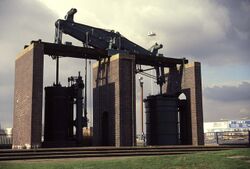History:Grazebrook beam engine
[ ⚑ ] 52°29′33″N 1°53′17″W / 52.49258°N 1.88818°W The Grazebrook Engine is an 1817 beam engine that was used for blowing air over the hot coals of a blast furnace to increase the heat. It is now found as sentinel sculpture on the Dartmouth Circus roundabout at the entrance of the A38(M) in Birmingham, England . It is believed to be the largest steam engine used in Birmingham.[citation needed]
It was built in 1817 to the designs of Watt, who had a foundry in Soho, Birmingham, by Grazebrook & Whitehouse for their Dudley foundry in Dudley, Worcestershire. It provided air for two blast furnaces.[1] In 1912, it was retired, remaining on site as a standby engine. It was dismantled in 1964, and is now displayed on the Dartmouth Circus roundabout at the entrance of the A38(M) (Aston Expressway) and the A4540 (Dartmouth Middleway).[citation needed]
Technical details
This is a typical example of an early nineteenth century engine, it comprises a vertical double acting steam cylinder coupled via an 8 metres (26 ft) rocking beam to a double acting air cylinder.[2]
The beam is made of cast iron; it is 28 feet (8.5 m) long and weighs 10 long tons (10 t). The steam cylinder is 42 inches (1,100 mm) in diameter and has a stroke of 8 feet (2.4 m). It was designed to run at between 12 and 16 strokes per minute. Steam was provided by a bank of six Lancashire boilers. A pressure regulator vessel was fitted to smooth out the air flow. It provided air at 5 pounds per square inch (34 kPa) to two blast furnaces.[1]
The engine house was specially built using lime mortar so that the structure could 'flex' with the movement of the engine.[1]
M. & W. Grazebrook
Grazebrook had a works in Peartree Lane, Netherton, possibly during 1952/53. [3] M. & W. Grazebrook's history can be traced to 1641, when Michael Grazebrook went into business in Stourbridge. The company had a glassworks in Stourbridge, a forge at Halesowen in the 1700s and their own colliery in Coseley. It then focused on iron production and fabrications moving to Netherton in 1800.[4] It was served by the Grazebrook arm of the Dudley Canal.
References
- Notes
- ↑ 1.0 1.1 1.2 Dudley 2015.
- ↑ "PMSA database". UK. http://www.pmsa.org.uk/pmsa-database/5932/#sthash.V1oeUh9s.dpuf.
- ↑ "Grazebrooks Children's party 1953". UK. http://www.blackcountrybugle.co.uk/Memories-1950s-works-party/story-25759735-detail/story.html#ixzz3cAxPCCEh.
- ↑ "Dudley's industrial might in 1950s boom years". http://www.blackcountrybugle.co.uk/Black-Country-s-industrial-1950s-boom-years/story-26407806-detail/story.html#ixzz3cBBfLDlK.[yes|permanent dead link|dead link}}] Image of 84 feet (26 m) pressure vessel
- Bibliography
- "Grazebrook Beam Engine engine house". GB145_p/985: Dudley Archives. http://blackcountryhistory.org/collections/getrecord/GB145_p_985/. Retrieved 3 June 2015.
- "Records of M. & W. Grazebrook, Ltd., Netherton (heavy engineers and boiler makers)". The National Archives, Kew. http://discovery.nationalarchives.gov.uk/details/rd/1fd695a0-386a-44b6-86fe-428a6d427852. Retrieved 5 June 2015.
External links
 |


